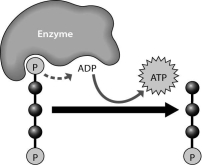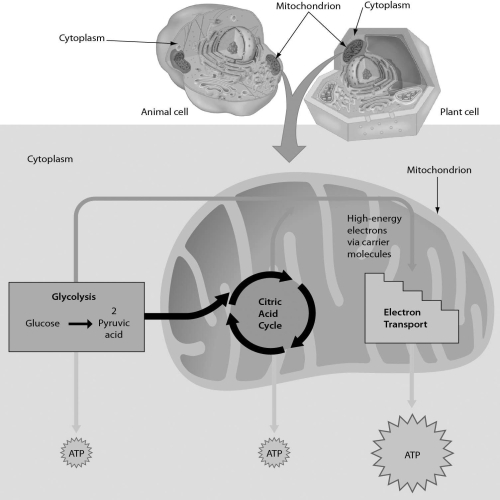A) ATP production
B) the citric acid cycle
C) lactic acid fermentation
D) glycolysis
Correct Answer

verified
Correct Answer
verified
Multiple Choice
Which of the following statements is TRUE?
A) Oxygen is a product of cellular respiration; carbon dioxide is a product of photosynthesis.
B) Lactic acid is a product of aerobic respiration; ethyl alcohol is a product of fermentation.
C) Oxidation is the loss of electrons; reduction is the gain of electrons.
D) Glucose is a product of aerobic respiration; lactic acid is a product of anaerobic respiration.
Correct Answer

verified
Correct Answer
verified
Multiple Choice
The ultimate source of the energy in food is ________.
A) the sun
B) producers
C) ATP
D) consumers
Correct Answer

verified
Correct Answer
verified
Multiple Choice
Scenario Questions Read the following scenario to answer the following questions. An abundant and continual supply of ATP is necessary for all living cells. Active muscle cells require an extraordinary amount of ATP to permit strenuous exercise for prolonged periods. Toxins, reduced blood flow, and a compromised respiratory system can interfere with the transport of oxygen to active cells. A runner in a marathon faces multiple obstacles to continue to produce sufficient ATP to remain competitive. -Breathing faster when we exercise is necessary to expel ________.
A) carbon dioxide and bring in more oxygen to support aerobic metabolism
B) oxygen and bring in more carbon dioxide to support aerobic metabolism
C) carbon dioxide and bring in more oxygen to support anaerobic metabolism
D) oxygen and bring in more carbon dioxide to support anaerobic metabolism
Correct Answer

verified
Correct Answer
verified
Multiple Choice
The table below shows experimental data from poultry scientists. Examine the table to answer the following questions.
Oviposition time, egg weight, chicken hatch weight and hatch weight/egg weight from young and mid-age broiler breeder flocks.

 -If the egg was weighed halfway between being laid and hatching,how would you expect that weight to compare to the weight of the newly hatched chick?
-If the egg was weighed halfway between being laid and hatching,how would you expect that weight to compare to the weight of the newly hatched chick?
A) The egg would weigh more at this midpoint than when newly hatched because, during development, the chick gains new parts.
B) The egg would weigh more at this midpoint than when newly hatched because it is taking in oxygen.
C) The egg would weigh less at this midpoint than when newly hatched because the shell wears away over time.
D) The egg would weigh less at this midpoint than when newly hatched because some of the mass of the egg would be released through cell respiration.
Correct Answer

verified
Correct Answer
verified
Multiple Choice
Which of the following are produced as a result of cellular respiration?
A) ATP and water
B) carbon dioxide and ATP
C) carbon dioxide, water, and ATP
D) oxygen and glucose
Correct Answer

verified
Correct Answer
verified
Multiple Choice
Lactic acid build up in muscles is a sign that ________.
A) aerobic respiration capacity has not been reached
B) respiration is operating effectively
C) insufficient oxygen is reaching the muscles
D) the muscles will be able to operate continuously for a long time
Correct Answer

verified
Correct Answer
verified
Multiple Choice
Which of these stages of cell respiration can occur without the others?
A) the electron transport chain
B) the citric acid cycle
C) lactic acid fermentation
D) glycolysis
Correct Answer

verified
Correct Answer
verified
Multiple Choice
A child is born with a rare disease in which mitochondria are missing from certain skeletal muscle cells.Physicians find that the muscle cells function.Not surprisingly,they also find that ________.
A) the muscles contain large amounts of lactic acid following even mild physical exercise
B) the muscles contain large amounts of carbon dioxide following even mild physical exercise
C) the muscles require extremely high levels of oxygen to function
D) the muscle cells cannot split glucose to pyruvic acid
Correct Answer

verified
Correct Answer
verified
Multiple Choice
Some friends are trying to make wine in their basement.They've added yeast to a sweet grape juice mixture and have allowed the yeast to grow.After several days,they find that sugar levels in the grape juice have dropped,but there's no alcohol in the mixture.The most likely explanation is that ________.
A) the mixture needs more sugar; yeast need a lot of energy before they can begin to produce alcohol
B) the mixture needs less oxygen; yeast only produce alcohol in the absence of oxygen
C) the mixture needs more oxygen; yeast need oxygen to break down sugar to produce alcohol
D) the mixture needs less sugar; high sugar concentrations stimulate cellular respiration, and alcohol is not a by-product of cellular respiration
Correct Answer

verified
Correct Answer
verified
Multiple Choice
Respiration describes the exchange of gases between your blood and the air.Cellular respiration ________.
A) produces ATP
B) produces oxygen
C) produces glucose
D) uses carbon dioxide
Correct Answer

verified
A
Correct Answer
verified
Multiple Choice
In cellular respiration,most ATP is produced DIRECTLY as a result of ________.
A) the movement of hydrogen ions across the inner mitochondrial membrane
B) the citric acid cycle
C) fermentation
D) the electron transport chain
Correct Answer

verified
Correct Answer
verified
Multiple Choice
Which of these equations describes aerobic cellular respiration?
A) glucose → lactic acid + energy
B) energy + carbon dioxide + water → glucose + oxygen + water
C) glucose + oxygen → carbon dioxide + water + energy
D) none of the above
Correct Answer

verified
C
Correct Answer
verified
Multiple Choice
A product of glycolysis is ________.
A) lactic acid
B) ethyl alcohol
C) O₂
D) pyruvic acid
Correct Answer

verified
Correct Answer
verified
Multiple Choice
Which of the following is a result of glycolysis?
A) production of CO₂
B) conversion of glucose to pyruvic acid
C) a net loss of two ATPs per glucose molecule
D) conversion of NADH to NAD⁺
Correct Answer

verified
Correct Answer
verified
Multiple Choice
Art Questions
 -What does the figure below show?
-What does the figure below show? 
A) the synthesis of ADP
B) the breakdown of ATP to perform cellular work
C) the removal of a phosphate group from ADP
D) the synthesis of ATP through the addition of a phosphate group
Correct Answer

verified
D
Correct Answer
verified
Multiple Choice
A horse eating some hay is an example of ________.
A) an autotroph eating a producer
B) an autotroph eating a consumer
C) a consumer eating a producer
D) a consumer eating a heterotroph
Correct Answer

verified
Correct Answer
verified
Multiple Choice
Art Questions
 -Examine the following figure.Which of these stages occur(s) in the cytoplasm?
-Examine the following figure.Which of these stages occur(s) in the cytoplasm? 
A) glycolysis
B) citric acid cycle
C) glycolysis and citric acid cycle
D) citric acid cycle and electron transport
Correct Answer

verified
Correct Answer
verified
Multiple Choice
Several students were talking about which came first in the history of the Earth.Which student has the best understanding of what happened?
A) Photosynthetic producers must have come first to provide food for other organisms.
B) Anaerobic bacteria must have come first because there was no carbon dioxide in the atmosphere.
C) Photosynthetic producers must have come first to provide oxygen for other organisms.
D) Anaerobic organisms must have come first because there was no oxygen in the atmosphere.
Correct Answer

verified
Correct Answer
verified
Multiple Choice
Plants use photosynthesis to
A) store chemical energy, and they use cellular respiration to harvest energy.
B) change light energy into chemical energy as well as to harvest chemical energy.
C) harvest energy, and they use cellular respiration to store chemical energy.
D) change light energy into sugars.
Correct Answer

verified
Correct Answer
verified
Showing 1 - 20 of 51
Related Exams